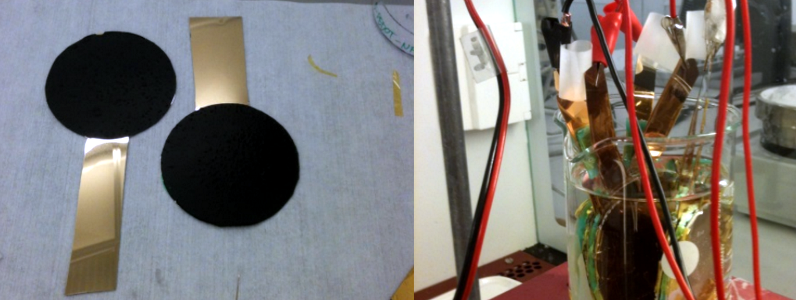Swedish scientists have created something they call power paper by using nanocellulose and a conductive polymer. The paper is highly conductive and has applications in supercapacitor technology and printed electronics.
The paper, technically called NFC-PEDOT paper, combines high conductivity and compatibility with conventional paper handling machines that could lead to less expensive manufacturing. The team used the material to create supercapacitors (up to 2F) as well as FET-like transistors known as OECTs (Organic Electrochemical Transistors).
Admittedly, the supercapacitor prototype didn’t look very practical (as they dunked it in a beaker full of potassium chloride). The black-colored paper is relatively conductive (42,000 S/m at 20 degrees C), at least for a paper. As a point of reference, silicon is about 1,000 S/m and iron conducts at about 10,000,000 S/m.
What can we do with NFC-PEDOT? Time will tell. We couldn’t help but wonder, however, if paper-based 3D printing couldn’t be adapted to use paper as an insulator or dielectric, foil as a conductor, and something like this material to build resistive elements. After all, we’ve seen something similar using foil and paper before.
















Remember Elroy’s cereal box with a built in TV screen, in an episode of The Jetsons? That’s what this should be used for.
Like this?
https://www.youtube.com/watch?v=ccCJfwnFU_Q
Swedish*
No idea why my spell checker thinks the other way is OK. Thanks!
Interesting, more of a because we can than being practical. However the most impressive supercapacitors to date use porous carbon micro sphere coated graphite paper, at 4,200 farads per gram they laugh at this but the same could be applied to this cellulose paper for equal results.
I don’t see how F/g of electrode material is relevant. Substrate and electrolyte will be orders of magnitude more (electrolyte out of principal, something has to fill the volume and conduct, substrate out of practicality). Less a figure of merit, more a figure of bullshit.
I give it half an hour before its all over Facebook with the tag line “Boffins find way to charge your mobile phone in 10 seconds using paper!”, and everyone whinging about how their space-tech pocket portal to the worlds knowledge only lasts a day and is rubbish…
If it weren’t for patents you’d have your space age batteries/supercaps unfortunately 2000mAh per gram batteries and 4700F/g supercaps have been locked up since 2008 with no foreseeable production planned.
Would be interested in reading about this, any source links?
On the other hand, if it weren’t for patents, the inventors would have probably never bothered to research them :P
There is always the option of keeping them as trade secrets. e.g. Coke recipe
The whole point for patents are/WERE the disclosure aspect of them.
From what I’ve seen 99.9% of material research is done in universities rather than by companies.
But I’m not sure that matter in terms of going after the money anymore.
Link to the patent or you’re a crackpot.